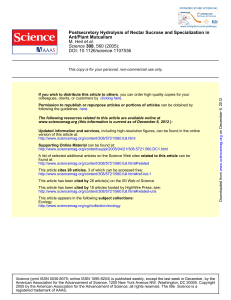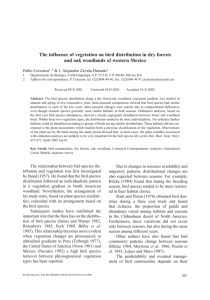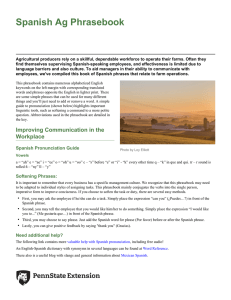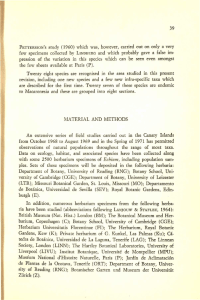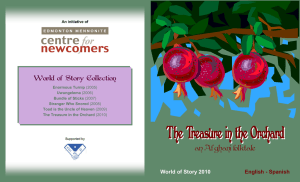The case for conserving Acacia with a new type
Anuncio
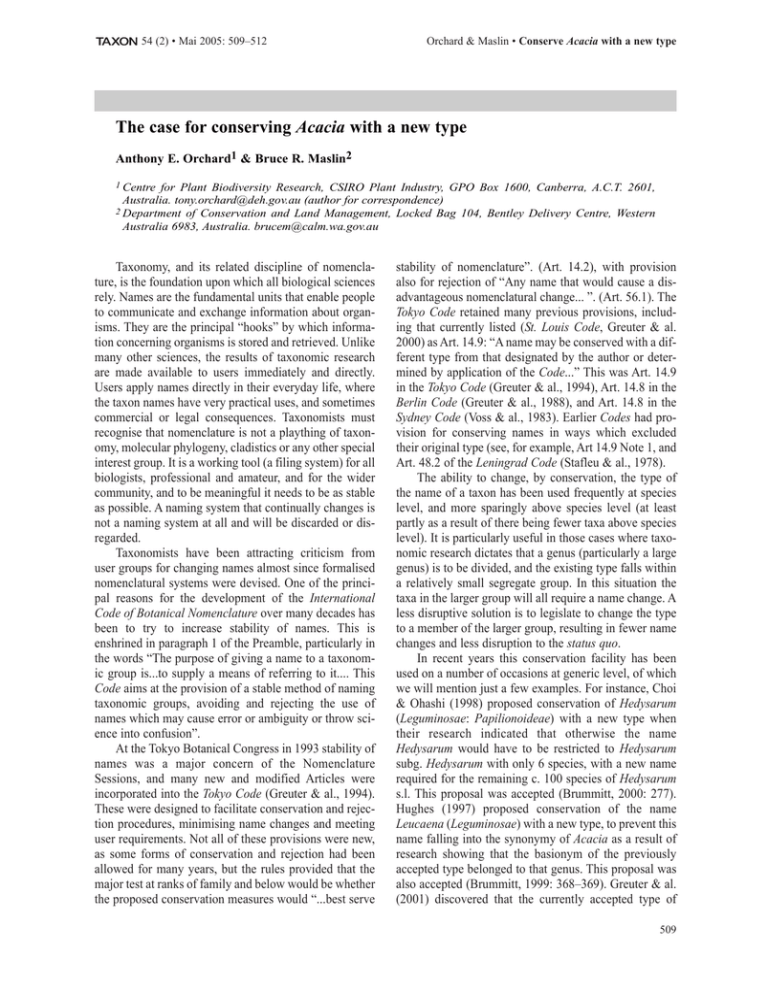
54 (2) • Mai 2005: 509–512 Orchard & Maslin • Conserve Acacia with a new type The case for conserving Acacia with a new type Anthony E. Orchard1 & Bruce R. Maslin2 1 Centre for Plant Biodiversity Research, CSIRO Plant Industry, GPO Box 1600, Canberra, A.C.T. 2601, Australia. [email protected] (author for correspondence) 2 Department of Conservation and Land Management, Locked Bag 104, Bentley Delivery Centre, Western Australia 6983, Australia. [email protected] Taxonomy, and its related discipline of nomenclature, is the foundation upon which all biological sciences rely. Names are the fundamental units that enable people to communicate and exchange information about organisms. They are the principal “hooks” by which information concerning organisms is stored and retrieved. Unlike many other sciences, the results of taxonomic research are made available to users immediately and directly. Users apply names directly in their everyday life, where the taxon names have very practical uses, and sometimes commercial or legal consequences. Taxonomists must recognise that nomenclature is not a plaything of taxonomy, molecular phylogeny, cladistics or any other special interest group. It is a working tool (a filing system) for all biologists, professional and amateur, and for the wider community, and to be meaningful it needs to be as stable as possible. A naming system that continually changes is not a naming system at all and will be discarded or disregarded. Taxonomists have been attracting criticism from user groups for changing names almost since formalised nomenclatural systems were devised. One of the principal reasons for the development of the International Code of Botanical Nomenclature over many decades has been to try to increase stability of names. This is enshrined in paragraph 1 of the Preamble, particularly in the words “The purpose of giving a name to a taxonomic group is...to supply a means of referring to it.... This Code aims at the provision of a stable method of naming taxonomic groups, avoiding and rejecting the use of names which may cause error or ambiguity or throw science into confusion”. At the Tokyo Botanical Congress in 1993 stability of names was a major concern of the Nomenclature Sessions, and many new and modified Articles were incorporated into the Tokyo Code (Greuter & al., 1994). These were designed to facilitate conservation and rejection procedures, minimising name changes and meeting user requirements. Not all of these provisions were new, as some forms of conservation and rejection had been allowed for many years, but the rules provided that the major test at ranks of family and below would be whether the proposed conservation measures would “...best serve stability of nomenclature”. (Art. 14.2), with provision also for rejection of “Any name that would cause a disadvantageous nomenclatural change... ”. (Art. 56.1). The Tokyo Code retained many previous provisions, including that currently listed (St. Louis Code, Greuter & al. 2000) as Art. 14.9: “A name may be conserved with a different type from that designated by the author or determined by application of the Code...” This was Art. 14.9 in the Tokyo Code (Greuter & al., 1994), Art. 14.8 in the Berlin Code (Greuter & al., 1988), and Art. 14.8 in the Sydney Code (Voss & al., 1983). Earlier Codes had provision for conserving names in ways which excluded their original type (see, for example, Art 14.9 Note 1, and Art. 48.2 of the Leningrad Code (Stafleu & al., 1978). The ability to change, by conservation, the type of the name of a taxon has been used frequently at species level, and more sparingly above species level (at least partly as a result of there being fewer taxa above species level). It is particularly useful in those cases where taxonomic research dictates that a genus (particularly a large genus) is to be divided, and the existing type falls within a relatively small segregate group. In this situation the taxa in the larger group will all require a name change. A less disruptive solution is to legislate to change the type to a member of the larger group, resulting in fewer name changes and less disruption to the status quo. In recent years this conservation facility has been used on a number of occasions at generic level, of which we will mention just a few examples. For instance, Choi & Ohashi (1998) proposed conservation of Hedysarum (Leguminosae: Papilionoideae) with a new type when their research indicated that otherwise the name Hedysarum would have to be restricted to Hedysarum subg. Hedysarum with only 6 species, with a new name required for the remaining c. 100 species of Hedysarum s.l. This proposal was accepted (Brummitt, 2000: 277). Hughes (1997) proposed conservation of the name Leucaena (Leguminosae) with a new type, to prevent this name falling into the synonymy of Acacia as a result of research showing that the basionym of the previously accepted type belonged to that genus. This proposal was also accepted (Brummitt, 1999: 368–369). Greuter & al. (2001) discovered that the currently accepted type of 509 Orchard & Maslin • Conserve Acacia with a new type Centaurea (Compositae) belonged to a small group of 32 species proposed for segregation as Bielzia. The remaining 400 to 700 species of Centaurea s.l. would require new combinations. The Committee for Spermatophyta agreed (Brummitt, 2004a: 818) that this disadvantageous situation should be avoided by conserving a new type for Centaurea. Similar proposals are in progress. For example, Ross (2004) has proposed conserving the name of the well-known genus Bossiaea (59 species; Leguminosae) against Platylobium (currently 4 species) to prevent the undesirable creation and adoption of many new combinations if the two genera are merged. The underlying principle here is exactly the same as the other examples above: to foster stability of nomenclature through peer-reviewed legislated exceptions to the rules. It is thus clear that our proposal (Orchard & Maslin, 2003) to conserve Acacia with a new type to avoid adoption of over 1000 new combinations does not lack precedent. This is a well-tried and accepted procedure under the Code. The only question is whether such an action is advantageous or disadvantageous for nomenclatural stability and thus for user groups. The nomenclatural history of Acacia is discussed in detail by B. R. Maslin, A. E. Orchard & J. West on the WorldWideWattle website at http://www.worldwidewat tle.com/infogallery/taxonomy/nomen-class.pdf. Briefly, the genus Acacia as currently accepted is a cosmopolitan group of about 1350 species, the second largest genus in the family Leguminosae. For the last 20–30 years evidence has been accumulating from morphology (seeds, seedlings, stipules), palynology, chemistry (seed amino acids, flavonoids), and more recently, from molecular and cladistic studies, that Acacia is polyphyletic, and a consensus is gradually emerging for the recognition of five segregate genera. The largest of these, with about 960 species is the current A. subg. Phyllodineae, for which the name Racosperma is available. The next largest is A. subg. Aculeiferum with about 203 species, and for which the name Senegalia is available. The third major group, that presently known as A. subg. Acacia, contains about 161 species, including the current type of Acacia, A. nilotica. The name Vachellia is available for this group. The remaining two groups are small, and comprise 15 and 13 species, respectively. It must be noted that if the proposed split of Acacia s. l. goes ahead, as it seems it will, then the 230 or so species assigned to Senegalia and the two small segregates will need new names irrespective of the outcome of our proposal. The discussion, then, comes down to whether it is better to retain the current type in A. subg. Acacia and adopt 960 new species combinations in A. subg. Phyllodineae (under the name Racosperma), or whether it is better to move the type to the current A. subg. Phyllodineae, and adopt the many fewer new com510 54 (2) • Mai 2005: 509–512 binations in what is currently A. subg. Acacia (under the name Vachellia). This case was considered in great detail by the Committee for Spermatophyta, with extensive correspondence from parties on both sides of the argument. Their conclusion was to recommend acceptance of the proposal to conserve Acacia with a new type, A. penninervis, from the Phyllodineae subgenus. In recognition of the intense interest in the case, the Secretary published a special report devoted to just this one case (Brummitt, 2004b) in which he set out the reasons for their decision. The number of species of the Australasian group, A. subg. Phyllodineae is vastly greater (almost 6 times greater) than those in A. subg. Acacia. Therefore, conserving Acacia with a new type results in far fewer new combinations to be absorbed by the user community. This user community is global in scope, and comprises those who must re-educate users in the new names, those who must reprint plant labels in commercial plant nurseries, botanic gardens, national parks, education centres, interpretation centres and municipal parks, those who must rewrite and have passed amended legislation for protecting rare and endangered species, rare communities, and the international trade in plants, including declared weeds, those who must rewrite and reprint pamphlets, handbooks, guides, textbooks, floras, technical manuals and the like, those who are maintaining and updating databases of plant names, including not only taxonomists and herbaria, but conservation groups, nurserymen’s associations, heritage groups, natural history societies and others. For all of these groups, gross numbers are very important, irrespective of the distribution of individual taxa. For example, while widespread species may impact on more floras, rare species will feature much more widely in conservation literature and legislation. Whether the Orchard & Maslin proposal is adopted or not, about half the species of Acacia s.l. outside of Australia will change their name anyway, to Senegalia. If the type is not changed, then usage of the name Acacia in Africa, the Americas, and Asia will become ambiguous. It will not be clear (unless specifically stated on each occasion) whether use of the name “Acacia” is in the old sense of 1350 species, or in the new sense of just 161 species. If all native taxa of Acacia s.l. in Africa, the Americas, and Asia change their names to either Vachellia or Senegalia, then there will be no ambiguity. Use of the name Acacia in these regions thenceforth can only refer to introduced members of Acacia subg. Phyllodineae or to one of the very few native species of that group in Asia and Madagascar. It is very important to recognize that members of the Phyllodineae group, although originally confined to Australia, Madagascar, and SE Asia, are now widely 54 (2) • Mai 2005: 509–512 used commercially, environmentally and/or socially in all continents, and in many places species have escaped to become woody weeds. This is discussed in Maslin, Orchard & West on the website cited above, but briefly, about 157 species of A. subg. Phyllodineae have been exported to around 71 countries for trial purposes, mainly in Africa, the Middle East, Asia and South America (with fewer in Europe and North America). A number of these species are now grown in large commercial plantations for industrial timber, fibre and tannin, and in smaller scale plantations for fodder, soil conservation, human food, firewood, floriculture and other purposes. Acacia mearnsii (subg. Phyllodineae) is the most profitable forestry species in South Africa, and plantations of this species in South Africa, Brazil, China and Vietnam generate income of US$ 571 million per annum. Other species of this group (A. mangium, auriculiformis, A. crassicarpa, A. difficilis) exported to Asia cover 1.5 m hectares in plantations in Indonesia, Malaysia, Vietnam and China, generating US$ 900 million from pulp alone. Acacia saligna is grown in plantations exceeding 500, 000 ha in North Africa, the Middle East, West Asia, and Chile. Seed of A. colei is becoming an important human food supplement in many places, especially in subSaharan Africa. Several species, including A. mearnsii, A. saligna, A. cyclops, A. melanoxylon and A. dealbata have become widespread weeds, and in some areas match or outnumber native Acacia (s.l.) species. They thus feature in floras far from their native range. This scale of utilisation is not matched by species of subgenus Acacia. A number of other minor points have been raised by those opposed to the Orchard & Maslin proposal. Our responses to these points are given in Maslin (2004) and Maslin & Orchard (2004). These two papers can be viewed on the WorldWideWattle website at http://www. worldwidewattle.com/infogallery/taxonomy/chronology.php. Finally, it is worth noting that Acacia in Australia is by far the largest genus in that continent, comprising 1 in about 18 of the native taxa. Not surprisingly it has become an iconic taxon in Australia where it assumes great symbolic and other significance. For example, A. pycnantha is the Australian official National Floral Emblem, a species of Acacia adorns the Australian Coat of Arms, green and gold (the predominant colours of Acacia) are Australia’s official National Colours, 1 September is officially declared Wattle Day, and the design of the Order of Australia medals (which recognize outstanding achievement and meritorious service of extraordinary Australians) is based on Acacia blossoms (see http://www.worldwidewattle.com/infogallery/sym bolic/ for details). There are enthusiastic amateur groups such as the Acacia Study Group and the Wattle Day Orchard & Maslin • Conserve Acacia with a new type Association, which are devoted to preserving and promoting Acacia as an important part of Australia’s cultural heritage. Furthermore, Acacia species form a major component of very many ecological assemblages across the continent (in many cases being the dominant or subdominant tree), and it is a widely planted genus in home gardens, streets and parks. No other taxonomic proposal has ever had the potential for disruption to nomenclature on a continental scale as the one to split Acacia. Unless the Orchard & Maslin proposal is accepted, 6% of the names in a continental flora will be changed overnight, with major flow-ons to user communities around the world. It is difficult to imagine a more “disadvantageous” outcome, nor one more likely to bring taxonomy and its practitioners into disrepute. LITERATURE CITED Brummitt, R. K. 1999. Report of the Committee for Spermatophyta: 48. Taxon 48: 359–371. Brummitt, R. K. 2000. Report of the Committee for Spermatophyta: 49. Taxon 49: 261–278. Brummitt, R. K. 2004a. Report of the Committee for Spermatophyta: 54. Taxon 53: 813–825. Brummitt, R. K. 2004b. Report of the Committee for Spermatophyta: 55. Proposal 1584 on Acacia. Taxon 53: 826–829. Choi, B. H. & Ohashi, H. 1998. (1377) Proposal to conserve the name Hedysarum (Leguminosae: Papilionoideae) with a conserved type. Taxon 47: 877. Greuter, W., Burdet, H. M., Chaloner, W. G., Demoulin, V., Grolle, R., Hawksworth, D., Nicolson, D. H., Silva, P. C., Stafleu, F. A., Voss, E. G. & McNeill, J. (eds.). 1988. International Code of Botanical Nomenclature. Adopted by the Fourteenth International Botanical Congress, Berlin, July–August 1987. Koeltz, Königstein. [Regnum Veg. 118: i–xiv; 1–328.] Greuter, W., Barrie, F., Burdet, H. M., Chaloner, W. G., Demoulin, V., Hawksworth, D. L., Jørgensen, P. M., Nicolson, D. H., Silva, P. C., Trehane, P. & McNeill, J. (eds.). 1994. International Code of Botanical Nomenclature (Tokyo Code). Adopted by the Fifteenth International Botanical Congress, Yokohama, August–September 1993. Koeltz, Königstein. [Regnum Veg. 131: 1–389.] Greuter, W., McNeill, J., Barrie, F. R., Burdet, H. M., Demoulin, V., Filgueiras, T. S., Nicolson, D. H., Silva, P. C., Skog, J. E., Trehane, P., Turland, N. J. & Hawksworth, D. L. (eds.). 2000. International Code of Botanical Nomenclature (Saint Louis Code). Adopted by the Sixteenth International Botanical Congress St. Louis, Missouri, July–August 1999. Koeltz, Königstein. [Regnum Veg. 138: 1–474.] Greuter, W., Wagenitz, G., Agababian, M. & Hellwig, F. H. 2001. (1509) Proposal to conserve the name Centaurea (Compositae) with a conserved type. Taxon 50: 1201–1205. Hughes, C. 1997. (1297) Proposal to conserve the name 511 Orchard & Maslin • Conserve Acacia with a new type Leucaena (Leguminosae) with a conserved type. Taxon 46: 355–356. Maslin, B. R. 2004. Response to Walker and Simpson’s views on the ICBN Proposal 1584 by Orchard and Maslin to conserve the name Acacia with a conserved type: ASBS Newsletter 117: 17–21 (2004). Austr. Syst. Bot. Soc. Newsl. 118: 15–19. Maslin, B. R. & Orchard, A. E. 2004. Response to Pedley’s paper titled “Another view of Racosperma” published in Acacia Study Group Newsletter 90: 3–5 (2004). Acacia Study Group Newsl. 93: 7–12. Orchard, A. E. & Maslin, B. R. 2003. (1584) Proposal to conserve the name Acacia (Leguminosae: Mimosoideae) with a conserved type. Taxon 52: 362–363. Ross, J. H. 2004. (1649) Proposal to conserve the name Bossiaea against Platylobium (Leguminosae). Taxon 53: 1075–1076, Stafleu, F. A., Demoulin, V., Greuter, W., Hiepko, P., Linczevski, A., McVaugh, R., Meikle, R. D., Rollins, R. C., Ross, R., Schopf, J. M. & Voss, E. G. 1978. International Code of Botanical Nomenclature Adopted by the Twelfth International Botanical Congress, Leningrad, July 1975. Bohn, Scheltema & Holkema, Utrecht. [Regnum Veg. 97: 1–457.] Voss, E. G., Burdet, H. M., Chaloner, W. G., Demoulin, V., Hiepko, P., McNeill, J., Meikle, R. D., Nicolson, D. H., Rollins, R. C., Silva, P. C. & Greuter, W. 1983. International Code of Botanical Nomenclature (Sydney Code). Adopted by the Thirteenth International Botanical Congress, Sydney, August 1981. Bohn, Scheltema & Holkema, Utrecht. [Regnum Veg. 111: 1–472.] 512 54 (2) • Mai 2005: 509–512
